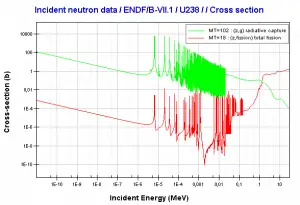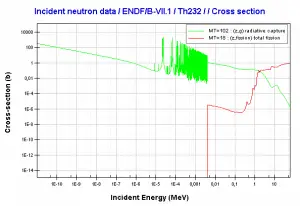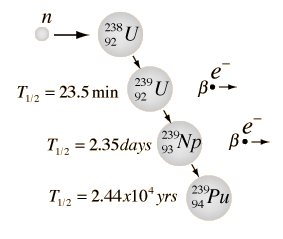Nuclear Fuel Breeding
All commercial light water reactors contain both fissile and fertile materials. For example, most PWRs use low enriched uranium fuel with enrichment of 235U up to 5%. Therefore more than 95% of the content of fresh fuel is fertile isotope 238U. During fuel burnup, the fertile materials (conversion of 238U to fissile 239Pu known as fuel breeding) partially replace fissile 235U, thus permitting the power reactor to operate longer before the amount of fissile material decreases to the point where reactor criticality is no longer manageable.
The fuel breeding in the fuel cycle of all commercial light water reactors plays a significant role. In recent years, the commercial power industry has been emphasizing high-burnup fuels (up to 60 – 70 GWd/tU), typically enriched to higher percentages of 235U (up to 5%). As burnup increases, a higher percentage of the total power produced in a reactor is due to the fuel bred inside the reactor.
On the other hand, this capture leads to the formation of unstable nuclei with higher neutron number. Such unstable nuclei undergo a nuclear decay, which may lead to the formation of other fissile nuclei. This process is also called nuclear transmutation and is responsible for new fuel breeding in nuclear reactors.
From this point of view, the neutron is utilized much more effectively when captured by 238U than when captured by absorber because the effective multiplication factor must in every state equal to 1 (Note that in PWRs, the boric acid is used to compensate an excess of reactivity of reactor core along the fuel cycle). In other words, it is better to capture the neutron (lower excess of reactivity) by 238U rather than by 10B nuclei.
At HFP (hot full power) state, the fuel temperature is directly given by:
- Local linear heat rate (W/cm) is given by neutron flux distribution. See also: Power Distribution.
- Fuel-cladding gap. As the fuel burnup increases, the fuel-cladding gap reduces. This reduction is caused by the swelling of the fuel pellets and cladding creep. Fuel pellets swelling occurs because fission gases cause the pellet to swell, resulting in a larger pellet volume. At the same time, the cladding is distorted by outside pressure (known as the cladding creep). These two effects result in direct fuel-cladding contact (e.g.,, at burnup of 25 GWd/tU). The direct fuel-cladding contact causes a significant reduction in fuel temperature profile because the overall thermal conductivity increases due to conductive heat transfer.
- Core inlet temperature. System parameters in steam generators directly give the core inlet temperature. When steam generators are operated at approximately 6.0MPa, the saturation temperature is equal to 275.6 °C. Since there must always be ΔT (~15°C) between the primary circuit and the secondary circuit, the reactor coolant (in the cold leg)have about 290.6°C (at HFP) at the inlet of the core. As the system pressure increases, the core inlet temperature must also increase. This increase causes a slight increase in fuel temperature.
It can be summarized the fuel breeding is lower when the reactor is operated at lower power levels. Note that additional absorbers must be inserted inside the core to lower the reactor power. The fuel breeding is higher (e.g.,, 1 EFPD surplus) when the core inlet temperature of the reactor coolant is higher (e.g.,, 1°C for 300 EFPDs). It must be added, the inlet temperature is limited, and it cannot be changed arbitrarily.
Comparison of cross-sections
Source: JANIS (Java-based nuclear information software) http://www.oecd-nea.org/janis/

http://www.oecd-nea.org/janis/
Uranium 238. Comparison of total fission cross-section and cross-section for radiative capture.

http://www.oecd-nea.org/janis/
Thorium 232. Comparison of total fission cross-section and cross-section for radiative capture.

Conversion Factor – Breeding Ratio
A quantity that characterizes this conversion of fertile into fissile material is known as the conversion factor. The conversion factor is defined as the ratio of fissile material created to fissile material consumed either by fission or absorption. If the ratio is greater than one, it is often referred to as the breeding ratio, for then the reactor is creating more fissile material than it is consuming.
When C is unity, one new atom is produced per one atom consumed. It seems fertile material can be converted indefinitely without adding new fuel. Still, the content of fertile uranium 238 decreases in real reactors, and fission products with significant absorption cross-section accumulate in the fuel as fuel burnup increases.
If we use a simplified model, which includes only uranium and plutonium-239, the conversion factor is:
This equation indicates that increased fuel enrichment results in a decreased value of C(0), the initial conversion factor. As the content of fissile material decreases with fuel burnup, the conversion factor increases. As this happens, an increasing fraction of the fission comes from plutonium.
See also: Conversion Factor

